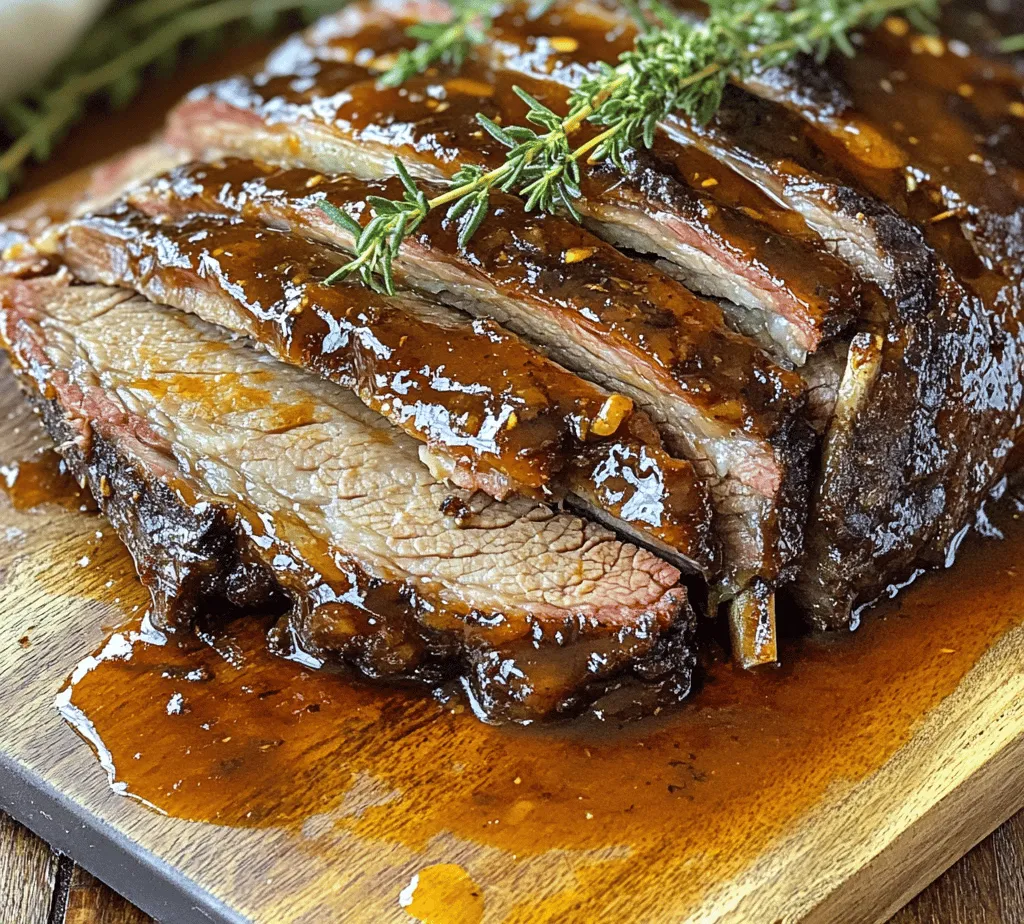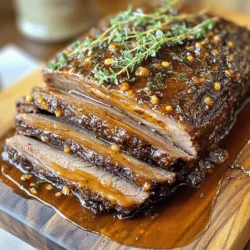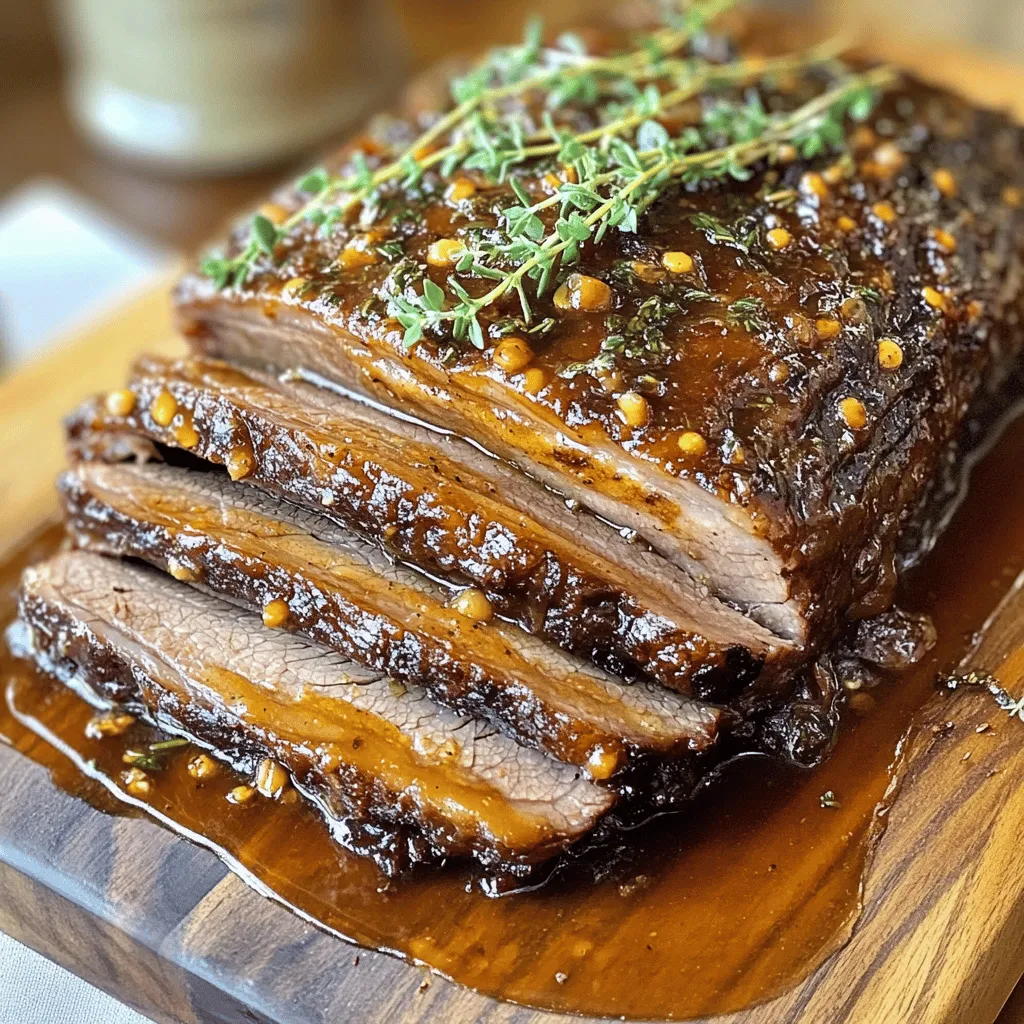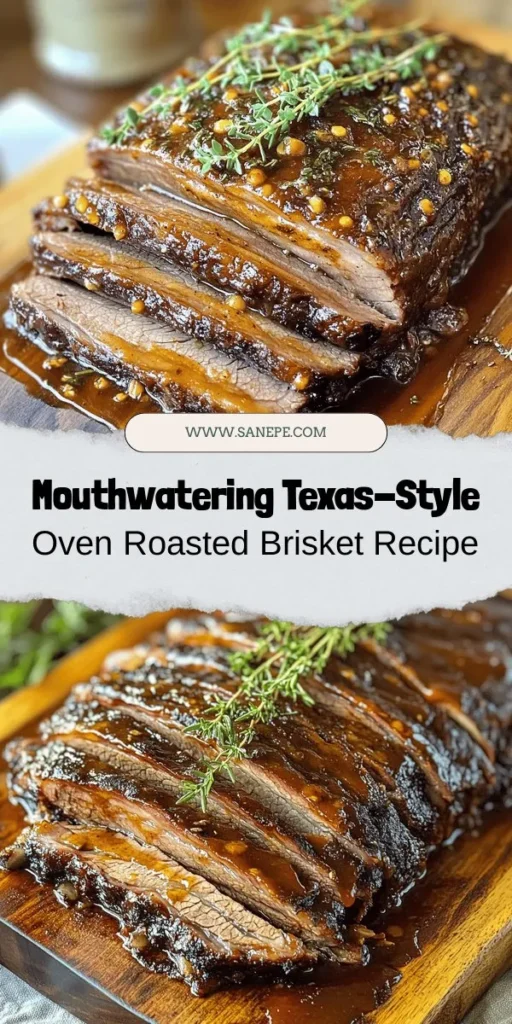Introduction
When it comes to barbecue, few dishes command the respect and admiration that Texas-style brisket does. Known for its tender, juicy texture and smoky flavor, brisket has become a hallmark of American barbecue culture, particularly in the Lone Star State. This cut of meat, steeped in tradition and history, is often the centerpiece of family gatherings, cookouts, and community feasts. But what makes Texas brisket so special? The answer lies not only in the quality of the meat but also in the slow-cooking methods that transform it into a flavor-packed delight.
Slow-cooking is crucial in bringing out the complex flavors and achieving that fall-apart tenderness that brisket is famous for. While traditional methods may involve hours of smoking on a barbecue pit, our Texas-style oven-roasted brisket recipe offers a simple yet equally delicious alternative for home cooks. This method allows you to enjoy the authentic taste of Texas brisket right in your own kitchen without the need for specialized equipment or outdoor grilling.
In this article, we will explore the rich history of brisket, delve into understanding the different cuts of this flavorful meat, and walk you through the essential ingredients and preparation steps required to create a mouthwatering Texas-style brisket in your oven.
Understanding Brisket
To fully appreciate the art of making Texas-style brisket, it’s essential to understand what brisket is and the different cuts available. Brisket is a cut of meat from the breast or lower chest of beef. It is known for its tough texture, which can be intimidating for some cooks. However, when cooked low and slow, this toughness transforms into tenderness thanks to the breakdown of collagen, resulting in a melt-in-your-mouth experience.
Brisket is typically divided into two main cuts: the flat cut and the point cut.
– Flat Cut: The flat cut is leaner and has less fat than the point cut. It is often preferred for slicing due to its uniform thickness and is commonly used in deli sandwiches. This cut is ideal for those who enjoy a more traditional brisket experience with less fat content.
– Point Cut: The point cut, on the other hand, is thicker and contains more marbling, which results in a richer flavor and juicier texture. This cut is often favored for barbecue enthusiasts who appreciate the robust taste that fat brings to the dish. It is also ideal for dishes that require shredding.
Nutritionally, beef brisket is a hearty source of protein, containing essential vitamins and minerals like zinc, iron, and B vitamins. While it is higher in fat compared to some other cuts, the flavor and richness it provides make it a favorite in many culinary traditions.
Essential Ingredients for Texas-Style Brisket
Creating the perfect Texas-style brisket requires a few key ingredients that contribute to its signature flavor profile. Below is a breakdown of these essential components:
– Beef Brisket: The star of the show, choosing the right cut of brisket is crucial. Look for a well-marbled cut, preferably a point cut for maximum flavor and moisture. When purchasing, aim for briskets that have a nice layer of fat on one side, as this will help keep the meat juicy during the cooking process.
– Olive Oil: This ingredient plays a vital role in the seasoning process. It helps the rub adhere to the brisket and keeps the meat moist during cooking. A good quality extra virgin olive oil is recommended for its rich flavor.
– Spices and Seasonings: The spice rub is what elevates the brisket to a whole new level. A blend of kosher salt, black pepper, garlic powder, onion powder, smoked paprika, and cayenne pepper creates a balanced flavor profile that complements the richness of the beef. Each of these spices contributes distinct notes that meld together during the cooking process.
– Beef Broth: This ingredient is used to create moisture in the oven, allowing the brisket to cook evenly and preventing it from drying out. It also adds depth to the overall flavor.
– Barbecue Sauce: While not strictly necessary, a high-quality barbecue sauce can be used to glaze the brisket during the last stages of cooking, adding an extra layer of flavor and enhancing the caramelization on the meat.
When selecting ingredients, it’s essential to prioritize quality. Fresh spices, high-quality meats, and homemade or artisanal sauces will significantly impact the final dish.
Preparation Steps for Perfect Brisket
Now that we’ve covered the essential ingredients, it’s time to dive into the preparation steps to ensure your Texas-style oven-roasted brisket turns out perfectly.
Preheating the Oven
Before you start preparing the brisket, preheating your oven is crucial to ensuring the meat cooks evenly. Set your oven to 300°F (150°C). This low and slow cooking method is vital for breaking down the tough fibers in the brisket. The goal is to create a gentle cooking environment that allows the brisket to become tender without burning the exterior.
Preparing the Brisket
Once your oven is preheated, it’s time to prepare the brisket. Start by removing the brisket from its packaging and patting it dry with paper towels. This step is important because a dry surface allows for better seasoning adherence and enhances the browning during cooking.
Next, trim any excessive fat from the brisket, leaving about a quarter-inch layer. This fat cap will render down during cooking, adding moisture and flavor to the meat. After trimming, place the brisket on a cutting board, fat side up, ready for seasoning.
Creating the Spice Rub
Now comes the fun part — creating the spice rub that will infuse your brisket with flavor. In a small mixing bowl, combine the following spices:
– 2 tablespoons kosher salt
– 1 tablespoon black pepper
– 1 tablespoon garlic powder
– 1 tablespoon onion powder
– 1 tablespoon smoked paprika
– ½ tablespoon cayenne pepper (adjust based on your spice preference)
Mix the spices thoroughly until they are well combined. The balance of salt, smoke, and heat in this rub will create a flavorful crust on your brisket as it cooks.
Once the rub is mixed, drizzle olive oil over the brisket, ensuring it is evenly coated. Then, generously sprinkle the spice rub over the brisket, pressing it into the meat to ensure it adheres well. Be sure to cover all sides of the brisket for maximum flavor.
As you prepare this dish, remember that patience is key. Allowing the brisket to rest with the spice rub for at least 30 minutes (or up to overnight in the refrigerator) will enhance the flavors even further, as the spices penetrate the meat.
In this section, we’ve laid the groundwork for your Texas-style oven-roasted brisket, covering its cultural significance, the essential cuts and ingredients, and the preparation steps to get you started. Stay tuned for the next part, where we’ll delve into the cooking process and tips for achieving that perfect, mouthwatering result.

Seasoning Techniques
When it comes to Texas-style oven-roasted brisket, the seasoning is paramount. A well-seasoned brisket not only enhances the flavor but also ensures that the spices penetrate deeply into the meat. To achieve this, you should start by applying a generous rub of salt and pepper, which is the classic base for brisket seasoning.
Importance of Even Coverage and Flavor Penetration:
Even coverage of your seasoning is crucial. Start by patting the brisket dry with paper towels, creating a clean surface for the rub to adhere. Use your hands or a spoon to apply the seasoning evenly across the entire surface of the meat. This allows the flavors to penetrate effectively while forming a delicious crust during the cooking process.
For an authentic Texas flavor, consider adding a mix of garlic powder, onion powder, smoked paprika, and a hint of cayenne pepper for an extra kick. These spices contribute to a complex flavor profile that resonates with the boldness of Texas barbeque. Allow the seasoned brisket to rest for at least 30 minutes (or up to overnight in the refrigerator) to let the flavors meld and intensify.
Searing the Brisket
Explanation of the Searing Process and Its Benefits:
Searing is an essential step in the brisket cooking process, as it creates a flavorful crust that locks in the juices. This caramelization occurs when the meat is exposed to high heat, resulting in a complex flavor that enhances the overall dish.
How to Achieve the Perfect Crust: Tips for Timing and Heat Levels:
To sear your brisket perfectly, heat a large skillet or a Dutch oven over medium-high heat and add a couple of tablespoons of oil with a high smoke point, like canola or avocado oil. Once the oil shimmers, carefully place the brisket in the pan. Sear each side for about 5 to 7 minutes, or until a rich, brown crust forms. Don’t rush this step; proper searing requires patience and attention to avoid burning the meat.
Choosing the Right Cookware for Searing and Roasting:
A heavy-bottomed skillet or Dutch oven is ideal for searing brisket, as it distributes heat evenly and can be transferred directly to the oven. Make sure your cookware has a lid for the roasting phase, or you can use aluminum foil to cover the brisket to retain moisture.
Roasting the Brisket
Creating a Moist Cooking Environment: The Role of Liquids:
After searing, it’s time to roast your brisket. Place it in the roasting pan and add a liquid of your choice—beef broth, beer, or even apple cider can all enhance the flavor while keeping the meat moist during cooking. The liquid will create steam, which helps in tenderizing the meat and preventing it from drying out.
Covering Techniques: Importance of Foil for Moisture Retention:
Cover the brisket tightly with aluminum foil or place a lid on your Dutch oven. This ensures that the moisture remains trapped inside, creating a humid environment that is essential for slow-roasting. If you prefer a crustier exterior, you can roast uncovered during the last hour of cooking.
Timing and Temperature for Optimal Tenderness: How to Know When It’s Done:
The key to perfectly roasted brisket is low and slow cooking. Preheat your oven to 225°F (107°C) and roast the brisket for approximately 1 hour per pound. Use a meat thermometer to check for doneness; the internal temperature should reach about 195-205°F (90-96°C) for optimal tenderness. At this temperature, the collagen in the meat breaks down, resulting in a juicy and fork-tender brisket.
Resting the Brisket
Importance of Resting Meat Post-Cooking:
Once your brisket is cooked, resist the urge to slice it immediately. Resting is crucial as it allows the juices to redistribute throughout the meat. Cutting too soon will lead to a loss of moisture, resulting in a drier brisket.
How Resting Affects Texture and Flavor Profile:
Let your brisket rest for at least 30-45 minutes under a tent of foil. This resting period will enhance the flavor profile and ensure each slice is tender and flavorful. The meat will continue to cook slightly during this time, bringing it to the perfect serving temperature.
Techniques for Keeping Brisket Warm While Resting:
To keep the brisket warm while it rests, place it in a cooler (without ice) or wrap it in towels. This method retains heat effectively, allowing the brisket to maintain its temperature without overcooking.
Slicing and Serving Suggestions
Best Practices for Slicing Brisket Against the Grain:
When ready to serve, use a sharp knife to slice the brisket against the grain. This is critical for achieving tender slices. Look for the direction of the muscle fibers and cut perpendicular to them. Aim for slices about ¼ inch thick for the best texture.
Presentation Ideas: Garnishes and Serving Suggestions:
For an appealing presentation, arrange the brisket slices on a large platter. You can garnish with freshly chopped parsley or chives for a pop of color. A drizzle of homemade barbecue sauce or a sprinkle of smoked sea salt adds an extra layer of flavor.
Ideal Side Dishes to Complement Texas-Style Brisket:
Pair your Texas-style brisket with classic sides such as creamy coleslaw, baked beans, cornbread, or potato salad. These sides not only complement the bold flavors of the brisket but also enhance the overall dining experience.
Conclusion
In summary, making Texas-style oven-roasted brisket involves several key steps: seasoning, searing, slow roasting, resting, and finally slicing. Each part of the process contributes to the creation of a delicious, tender, and flavorful dish that is perfect for gatherings or special occasions. The effort put into preparing this meal is truly worth it when you see the smiles on your loved ones’ faces as they enjoy a hearty, home-cooked feast.
We encourage you to try this recipe for your next family barbecue or holiday gathering. The joy of cooking and sharing a delicious meal with friends and family is unmatched, and there’s nothing quite like the satisfaction of serving a perfectly roasted brisket. So fire up your oven, gather your ingredients, and get ready to impress your guests with a true Texas classic.


